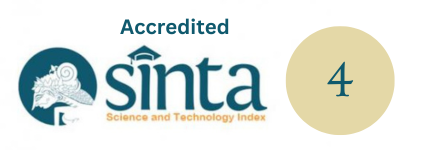Creative Percussion “Ilang” | Tabuh Kreasi “Ilang”
DOI:
https://doi.org/10.59997/jurnalsenikarawitan.v3i3.1673Keywords:
Creative Percussion, Ilang, Panca Sthiti Ngawi SaniAbstract
Ilang is a creative percussion composition inspired by the life of a stylist who feels the loss of a mother he loves. In the Balinese Indonesian dictionary, it is explained how the word Ilang means lost or lost. The meaning of loss can be in the form of sadness and suffering or a slap on the quality of fortitude and self-preparedness. Loss shows a sense of not being completely whole, feeling lacking without the presence of something or someone. Seeing the phenomenon that occurred, an inspiration emerged to lift Ilang into a title for musical composition in the form of creative percussion. The composition of this creative percussion uses the media expressed by Gamelan Semare Pagulingan Saih Pitu and is supported by vocal musicians (Gerong) as a medium for delivering messages that the stylist wants to convey to art connoisseurs. The method of creation used in Ilang's percussion works is the Panca Sthiti Ngawi Sani method which includes; 1 stage of inspiration (Ngawirasa), 2 stages of exploration (Ngawacak), 3 stages of conception (Ngarencana), 4 stages of execution (Ngawangun) and the last 5 stages of production (Ngebah). This work is approximately 13 minutes long, this work cultivates melodies, rhythms, and dynamics that are so harmonious and still uses the concept of tradition by using contemporary elements to create new nuances.
Keywords: Creative Percussion, Ilang, Panca Sthiti Ngawi Sani
Downloads
References
Aryasa, dkk. (1984). pengetahuan karawitan Bali. Departemen Pendidikan Dan Kebudayaan Direktorat Jendral Kebudayaan Proyek Pengembangan Kesenian Bali.
Bandem, I. M. (2013). Gamelan Bali di atas Panggung Sejarah. Badan Penerbit STIKOM Bali.
Budi Pramana, I. P. R., & Suharta, I. W. (2023). Contemporary Music Composition “Konfrontasi” | Komposisi Musik Kontemporer “Konfrontasi.” GHURNITA: Jurnal Seni Karawitan, 1(4), 290–298. https://doi.org/10.59997/jurnalsenikarawitan.v1i4.371
Dibia, I. W. (2020). Panca Sthiti Ngawi Sani: Metodologi Penciptaan Seni. Pusat Penerbitan LP2MPP Institut Seni Indonesia (ISI) Denpasar.
Kariasa, I. N., & Putra, I. W. D. (2021). Karya Karawitan Baru Manikam Nusantara. Mudra Jurnal Seni Budaya, 36(2), 222–229. https://doi.org/10.31091/mudra.v36i2.1471
Nurhidayati, N., & Chairani, L. (2014). Makna Kematian Orangtua Bagi Remaja (Studi Fenomenologi Pada Remaja Pasca Kematian Orangtua). Jurnal Psikologi, 10(1), 33–40. https://doi.org/10.24014/JP.V10I1.1177
Pratama, G. M. R., & -, S. (2023). Campuhan: A New Music Creation | Campuhan: Sebuah Musik Kreasi Baru. GHURNITA: Jurnal Seni Karawitan, 1(2), 92–99. https://doi.org/10.59997/jurnalsenikarawitan.v1i2.149
Pryatna, H. S. I. K. S. I. P. D. (2020). TEKNIK PERMAINAN KENDANG TUNGGAL PADA GAMELAN BALI. Pusat Penerbitan LP2MPP ISI Denpasar. http://repo.isi-dps.ac.id/3795/
Pryatna, I. P. D. H. S. (2020). Konsep Musikal Instrumen kendang Dalam Gamelan Gong Kebyar Bali. Resital: Jurnal Seni Pertunjukan, 21(2), 73–84. https://doi.org/10.24821/resital.v21i2.4220
Putu Paristha Prakasih, Hendra Santosa, I. G. Y. (2018). Tirtha Campuhan: Karya Komposisi Baru dengan Media Gamelan Semar Pagulingan. Resital: Jurnal Seni Pertunjukan, 19(3), 113–121. https://doi.org/10.24821/resital.v19i3.2452
Rianta, I. M., Santosa, H., & Sariada, I. K. (2019). Estetika Gerak Tari Rejang Sakral Lanang Di Desa Mayong, Seririt, Buleleng, Bali. Mudra Jurnal Seni Budaya, 34(3), 285–393. https://doi.org/10.31091/mudra.v34i3.678
Setyawan, I. P. Y., Sudhana, I. K., & Mariyana, I. N. (2022). Karawitan Composition Benang Raja | Komposisi Karawitan Benang Raja. GHURNITA: Jurnal Seni Karawitan, 2(2), 125–133. https://doi.org/10.59997/jurnalsenikarawitan.v2i2.491
Sukarta1, A. G., & I Ketut Muryana2. (2021). Ghurnita. 01(01), 29–36. https://doi.org/10.25124/ghurnita.v1i1.150








